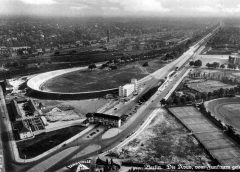AVUS 43 degrees is one of the most terrible Formula 1 tracks
The Germans, as you know, are a serious and pedantic people who are famous for their traditions of auto racing, and not only. We say “German cars” -we mean speed, drive and quality. We say “German pilots” -we mean Schumacher.
Once it was decided to use these same roads as racing ones. One of these roads, converted into racing roads, was the AVUS-a road for automobile traffic and training (Automobil-Verkehrs und Übungs-Straße). The name of the route is dry and strict. The Germans are the same.
The idea to make a highway out of a toll highway was born in the Automobile Club of Germany in 1907, and it was decided to build an AVUS in the Grunewald Forest, Berlin. But here’s the bad luck – there is not enough money, then suddenly the First World War crept up… The track was finally completed in 1921. It looks like something boring and incomprehensible. Especially if you look at modern inclined platforms.
2 straight lines and turns “Nordschleife” and “Sudschleife”. 12 miles. What is there to look at? In a straight line, and the monkey can go. However, remember the times when racers went to the races like to death, and what speeds they developed then. Not so much sugar.
On July 11, 1926, the first German Grand Prix was held at this track. The race became historic not only because it was the first Grand Prix of one of the greatest motorsport powers in the world, along with England, but also because it opened to the world a hitherto unknown seller in the Dresden dealership “Daimler-Benz” Rudolf Caracciola. The entire elite of Berlin and a huge crowd of spectators gathered at this race. The city was empty, everyone was present at the AVUS. eister, and Caracciola eventually made a brilliant career in motorsport.
The first German Grand Prix in AVUS was a great success, but it was overshadowed by a tragedy. Adolf Rosenberg’s Mercedes took the lives of a marshal and three spectators. In addition, the Nurburgring soon opened. As a result, it was decided to make AVUS the fastest track in the world, and for this purpose, a profiled turn with an angle of inclination of 43 degrees was built on the northern turn.
Banking immediately got the nickname “The Wall of Death”, not only was it really a wall, but the pilots passed it without the right to make mistakes, approaching the loop at high speed (remember that there is a straight line in front of it?) and at the same time, extremely accurately and accurately balancing the brake pedal. And if it was raining, do not hesitate to multiply the difficulty of passing the bank account by three. If you don’t get on the right trajectory, you will fly away like a rocket in the dreams of Soviet leaders.
AVUS really turned out to be an ultra-fast track, and in 1937 it was decided to hold the fastest race in history. Especially for her, “Auto Union” and “Mercedes” have developed so-called “streamliners”on the basis of their usual cars with open wheels. The race caused a serious stir, and Joseph Goebbel personally supervised its conduct.
Did you want a speed record? Get it. The average speed is 276 km / h for Bernd Rosemayer on the lap and 261 km/h for Hermann Lang in the race. These records were broken only in 1971 and 1967, respectively.
This was the brightest page in the history of AVUS. In 1938, Bernd Rosemayer died trying to set a speed record on the Frankfurt-Darschmadt highway, and therefore they wanted to finally close the AVUS due to the frightening speed characteristics of the highway. Racing on it was no longer held, and then the Second World War broke out.
In 1967, the banking was dismantled, and only DTM and Formula 3 remained on AVUS. Time passed, the AVUS was shortened, chicanes appeared, the Berlin Wall fell, the number of races decreased… There is no trace of his former greatness left. Lausitzring replaced AVUS, and in 1999 the legendary autodrom sang its swan song. In the end, it was decided to turn the “Road for Automobile Traffic and Exercises” simply into a road for automobile traffic.
Today it is an ordinary German highway with smooth asphalt, which is ironed by law-abiding Herr and Frau. One day, perhaps, you will also pass here in the latest Mercedes and will not even suspect that even before the war, great battles of the greatest pilots of that time took place here on super-fast cars, dying at the wheel of which was a matter of indifference.
It was a great track. Very quickly. Extremely dangerous.

